Analysis of Risk Management in Project Procurement and Strategy
VerifiedAdded on 2020/03/16
|14
|3677
|73
Report
AI Summary
This report delves into the critical aspects of risk management within project and procurement management, emphasizing their significance for project success. It aligns with ISO 31000's definition of risk management, which encompasses the identification, forecasting, evaluation, and prioritization of risks. The report examines various elements of effective risk management, including internal environments, risk assessment, risk response, control activities, communication, and monitoring. It outlines the steps involved in the risk management process, such as threat identification, vulnerability assessment, and consequence determination. Furthermore, the report discusses risk mitigation options like avoidance, reduction, sharing, and retention, while also addressing the measurement and ranking of risks to determine the likelihood of occurrence. The report also provides insights into procurement management within projects, covering the processes and standards required to procure necessary materials and services. Overall, the report offers a comprehensive analysis of risk management strategies and their application in project and procurement contexts.
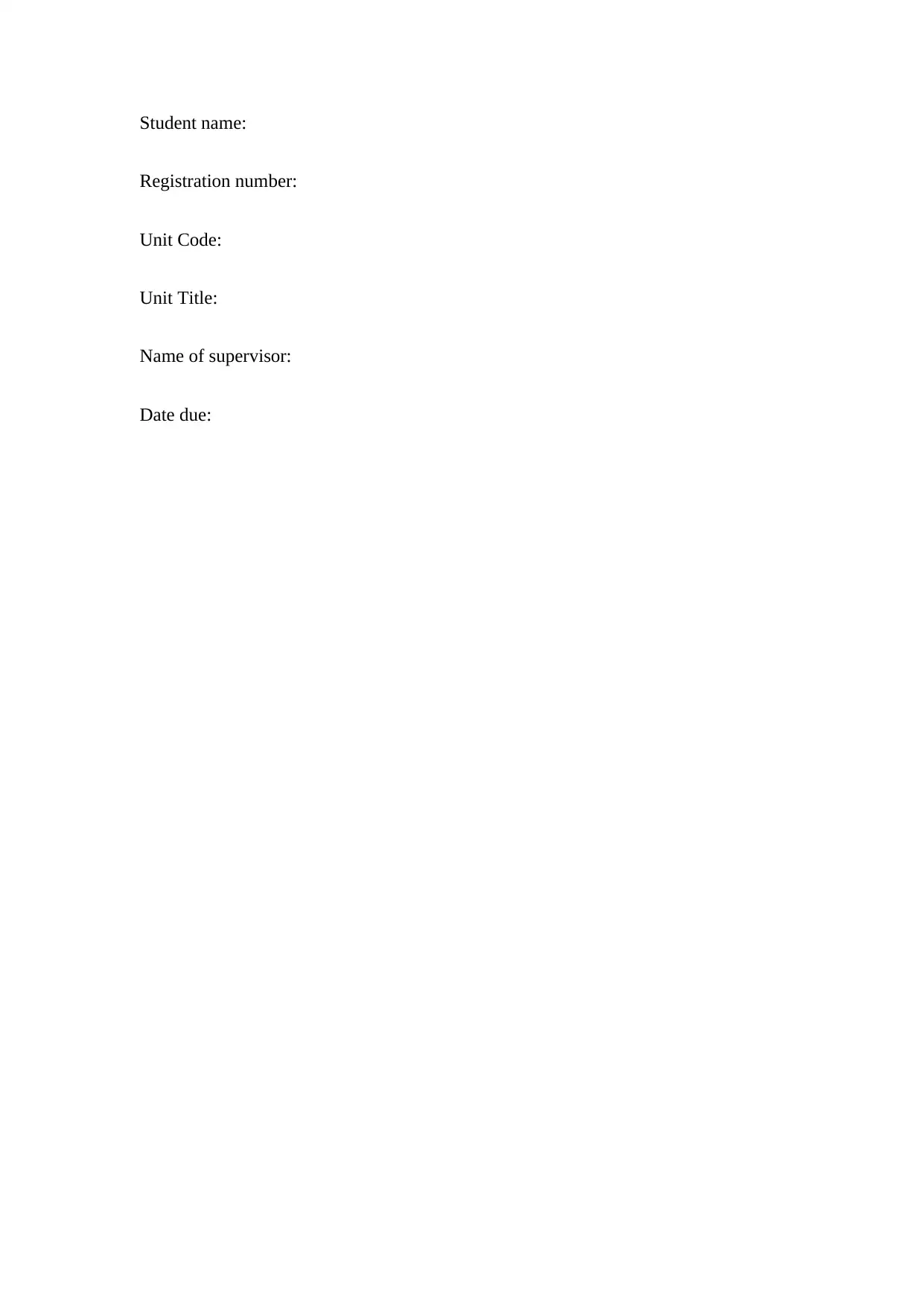
Student name:
Registration number:
Unit Code:
Unit Title:
Name of supervisor:
Date due:
Registration number:
Unit Code:
Unit Title:
Name of supervisor:
Date due:
Paraphrase This Document
Need a fresh take? Get an instant paraphrase of this document with our AI Paraphraser
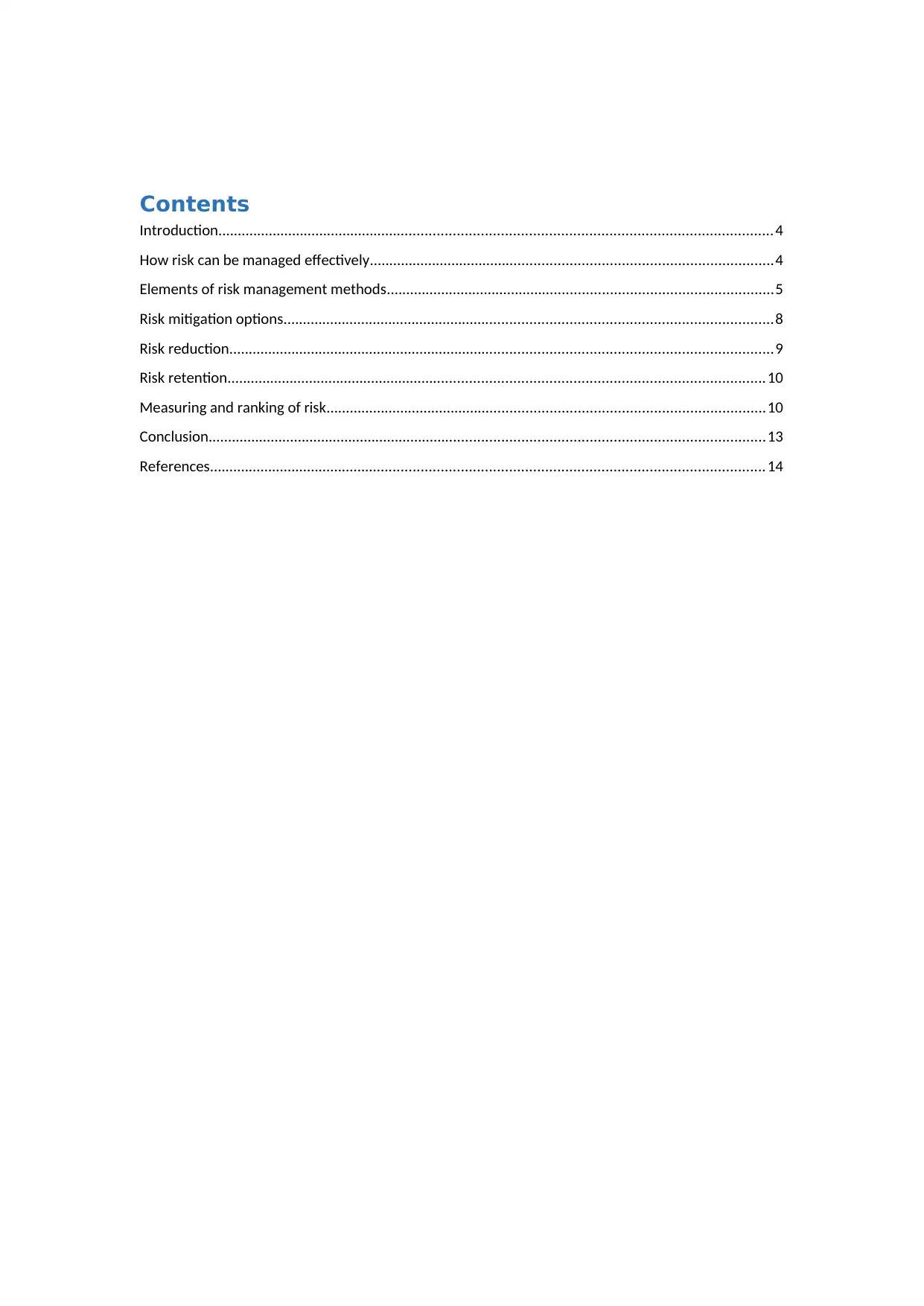
Contents
Introduction............................................................................................................................................4
How risk can be managed effectively......................................................................................................4
Elements of risk management methods..................................................................................................5
Risk mitigation options............................................................................................................................8
Risk reduction..........................................................................................................................................9
Risk retention........................................................................................................................................10
Measuring and ranking of risk...............................................................................................................10
Conclusion.............................................................................................................................................13
References............................................................................................................................................ 14
Introduction............................................................................................................................................4
How risk can be managed effectively......................................................................................................4
Elements of risk management methods..................................................................................................5
Risk mitigation options............................................................................................................................8
Risk reduction..........................................................................................................................................9
Risk retention........................................................................................................................................10
Measuring and ranking of risk...............................................................................................................10
Conclusion.............................................................................................................................................13
References............................................................................................................................................ 14
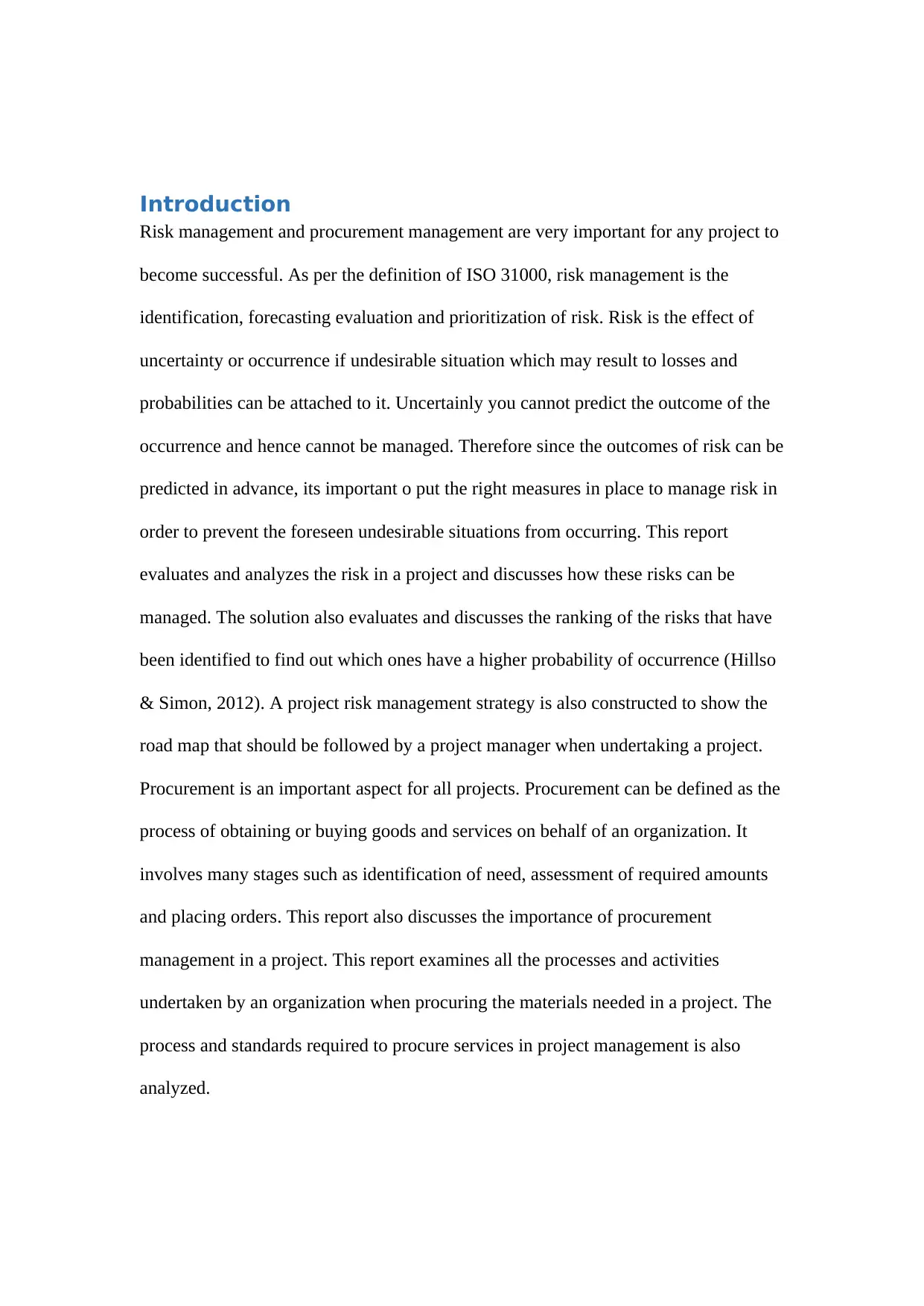
Introduction
Risk management and procurement management are very important for any project to
become successful. As per the definition of ISO 31000, risk management is the
identification, forecasting evaluation and prioritization of risk. Risk is the effect of
uncertainty or occurrence if undesirable situation which may result to losses and
probabilities can be attached to it. Uncertainly you cannot predict the outcome of the
occurrence and hence cannot be managed. Therefore since the outcomes of risk can be
predicted in advance, its important o put the right measures in place to manage risk in
order to prevent the foreseen undesirable situations from occurring. This report
evaluates and analyzes the risk in a project and discusses how these risks can be
managed. The solution also evaluates and discusses the ranking of the risks that have
been identified to find out which ones have a higher probability of occurrence (Hillso
& Simon, 2012). A project risk management strategy is also constructed to show the
road map that should be followed by a project manager when undertaking a project.
Procurement is an important aspect for all projects. Procurement can be defined as the
process of obtaining or buying goods and services on behalf of an organization. It
involves many stages such as identification of need, assessment of required amounts
and placing orders. This report also discusses the importance of procurement
management in a project. This report examines all the processes and activities
undertaken by an organization when procuring the materials needed in a project. The
process and standards required to procure services in project management is also
analyzed.
Risk management and procurement management are very important for any project to
become successful. As per the definition of ISO 31000, risk management is the
identification, forecasting evaluation and prioritization of risk. Risk is the effect of
uncertainty or occurrence if undesirable situation which may result to losses and
probabilities can be attached to it. Uncertainly you cannot predict the outcome of the
occurrence and hence cannot be managed. Therefore since the outcomes of risk can be
predicted in advance, its important o put the right measures in place to manage risk in
order to prevent the foreseen undesirable situations from occurring. This report
evaluates and analyzes the risk in a project and discusses how these risks can be
managed. The solution also evaluates and discusses the ranking of the risks that have
been identified to find out which ones have a higher probability of occurrence (Hillso
& Simon, 2012). A project risk management strategy is also constructed to show the
road map that should be followed by a project manager when undertaking a project.
Procurement is an important aspect for all projects. Procurement can be defined as the
process of obtaining or buying goods and services on behalf of an organization. It
involves many stages such as identification of need, assessment of required amounts
and placing orders. This report also discusses the importance of procurement
management in a project. This report examines all the processes and activities
undertaken by an organization when procuring the materials needed in a project. The
process and standards required to procure services in project management is also
analyzed.
⊘ This is a preview!⊘
Do you want full access?
Subscribe today to unlock all pages.

Trusted by 1+ million students worldwide
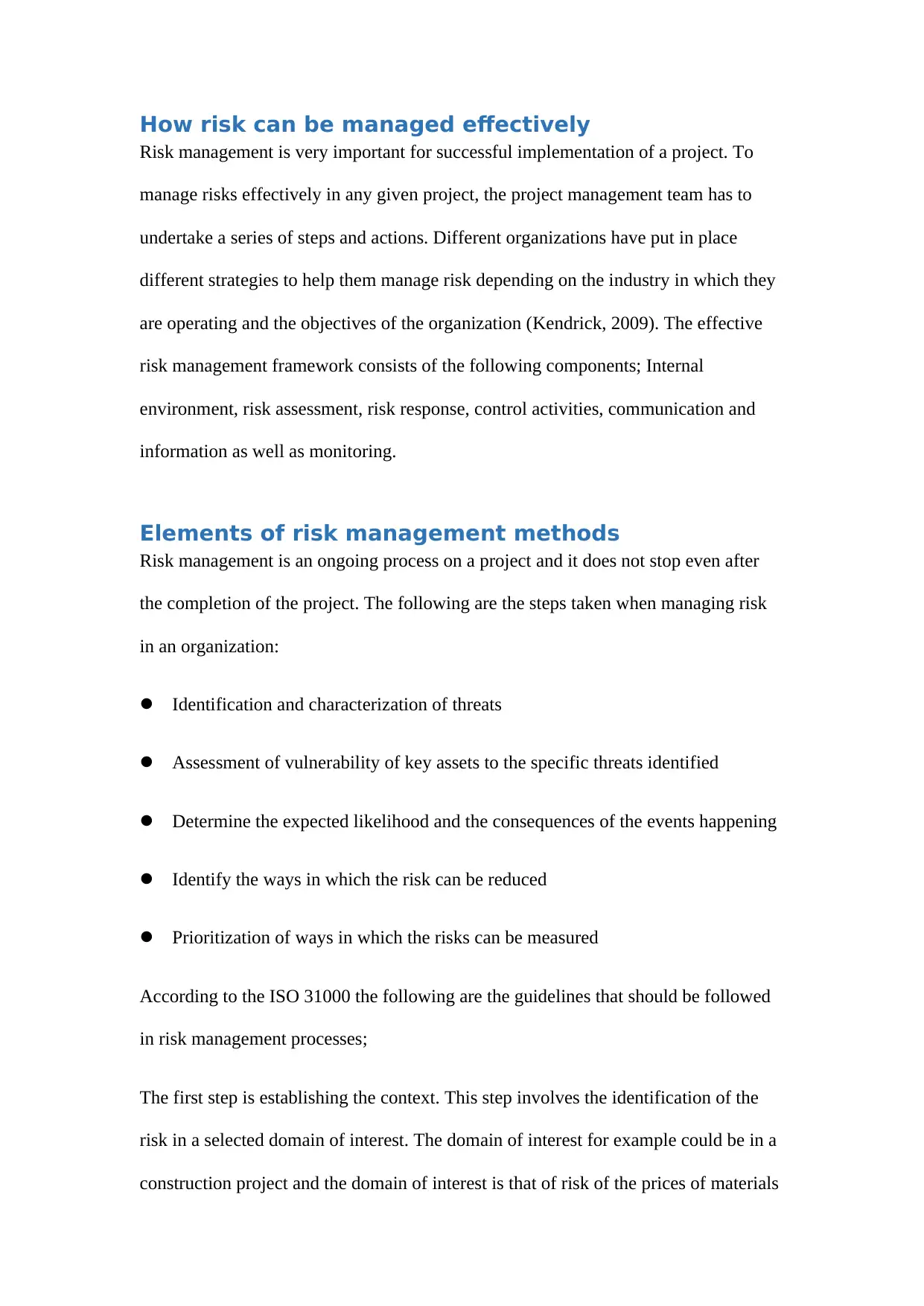
How risk can be managed effectively
Risk management is very important for successful implementation of a project. To
manage risks effectively in any given project, the project management team has to
undertake a series of steps and actions. Different organizations have put in place
different strategies to help them manage risk depending on the industry in which they
are operating and the objectives of the organization (Kendrick, 2009). The effective
risk management framework consists of the following components; Internal
environment, risk assessment, risk response, control activities, communication and
information as well as monitoring.
Elements of risk management methods
Risk management is an ongoing process on a project and it does not stop even after
the completion of the project. The following are the steps taken when managing risk
in an organization:
Identification and characterization of threats
Assessment of vulnerability of key assets to the specific threats identified
Determine the expected likelihood and the consequences of the events happening
Identify the ways in which the risk can be reduced
Prioritization of ways in which the risks can be measured
According to the ISO 31000 the following are the guidelines that should be followed
in risk management processes;
The first step is establishing the context. This step involves the identification of the
risk in a selected domain of interest. The domain of interest for example could be in a
construction project and the domain of interest is that of risk of the prices of materials
Risk management is very important for successful implementation of a project. To
manage risks effectively in any given project, the project management team has to
undertake a series of steps and actions. Different organizations have put in place
different strategies to help them manage risk depending on the industry in which they
are operating and the objectives of the organization (Kendrick, 2009). The effective
risk management framework consists of the following components; Internal
environment, risk assessment, risk response, control activities, communication and
information as well as monitoring.
Elements of risk management methods
Risk management is an ongoing process on a project and it does not stop even after
the completion of the project. The following are the steps taken when managing risk
in an organization:
Identification and characterization of threats
Assessment of vulnerability of key assets to the specific threats identified
Determine the expected likelihood and the consequences of the events happening
Identify the ways in which the risk can be reduced
Prioritization of ways in which the risks can be measured
According to the ISO 31000 the following are the guidelines that should be followed
in risk management processes;
The first step is establishing the context. This step involves the identification of the
risk in a selected domain of interest. The domain of interest for example could be in a
construction project and the domain of interest is that of risk of the prices of materials
Paraphrase This Document
Need a fresh take? Get an instant paraphrase of this document with our AI Paraphraser
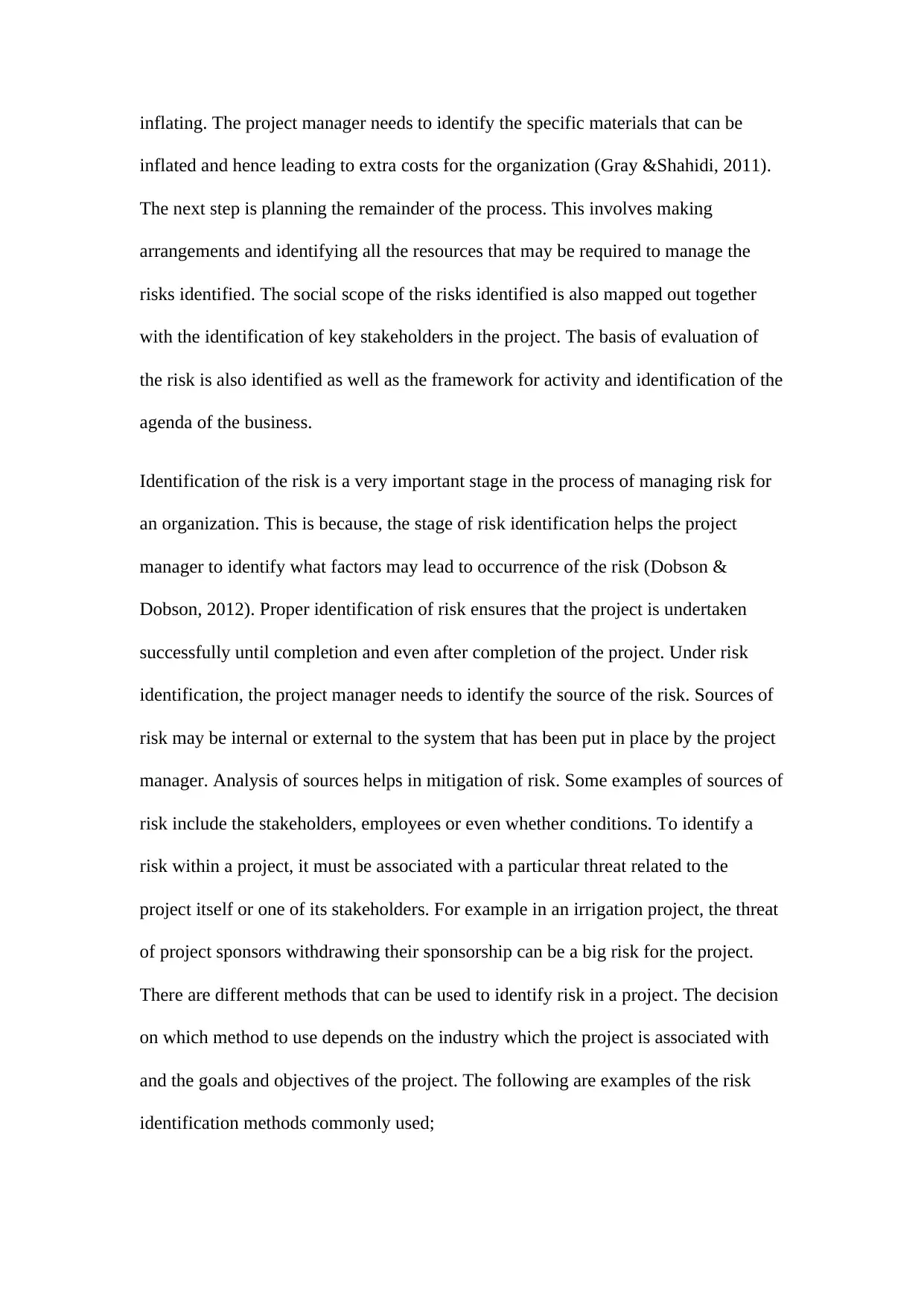
inflating. The project manager needs to identify the specific materials that can be
inflated and hence leading to extra costs for the organization (Gray &Shahidi, 2011).
The next step is planning the remainder of the process. This involves making
arrangements and identifying all the resources that may be required to manage the
risks identified. The social scope of the risks identified is also mapped out together
with the identification of key stakeholders in the project. The basis of evaluation of
the risk is also identified as well as the framework for activity and identification of the
agenda of the business.
Identification of the risk is a very important stage in the process of managing risk for
an organization. This is because, the stage of risk identification helps the project
manager to identify what factors may lead to occurrence of the risk (Dobson &
Dobson, 2012). Proper identification of risk ensures that the project is undertaken
successfully until completion and even after completion of the project. Under risk
identification, the project manager needs to identify the source of the risk. Sources of
risk may be internal or external to the system that has been put in place by the project
manager. Analysis of sources helps in mitigation of risk. Some examples of sources of
risk include the stakeholders, employees or even whether conditions. To identify a
risk within a project, it must be associated with a particular threat related to the
project itself or one of its stakeholders. For example in an irrigation project, the threat
of project sponsors withdrawing their sponsorship can be a big risk for the project.
There are different methods that can be used to identify risk in a project. The decision
on which method to use depends on the industry which the project is associated with
and the goals and objectives of the project. The following are examples of the risk
identification methods commonly used;
inflated and hence leading to extra costs for the organization (Gray &Shahidi, 2011).
The next step is planning the remainder of the process. This involves making
arrangements and identifying all the resources that may be required to manage the
risks identified. The social scope of the risks identified is also mapped out together
with the identification of key stakeholders in the project. The basis of evaluation of
the risk is also identified as well as the framework for activity and identification of the
agenda of the business.
Identification of the risk is a very important stage in the process of managing risk for
an organization. This is because, the stage of risk identification helps the project
manager to identify what factors may lead to occurrence of the risk (Dobson &
Dobson, 2012). Proper identification of risk ensures that the project is undertaken
successfully until completion and even after completion of the project. Under risk
identification, the project manager needs to identify the source of the risk. Sources of
risk may be internal or external to the system that has been put in place by the project
manager. Analysis of sources helps in mitigation of risk. Some examples of sources of
risk include the stakeholders, employees or even whether conditions. To identify a
risk within a project, it must be associated with a particular threat related to the
project itself or one of its stakeholders. For example in an irrigation project, the threat
of project sponsors withdrawing their sponsorship can be a big risk for the project.
There are different methods that can be used to identify risk in a project. The decision
on which method to use depends on the industry which the project is associated with
and the goals and objectives of the project. The following are examples of the risk
identification methods commonly used;
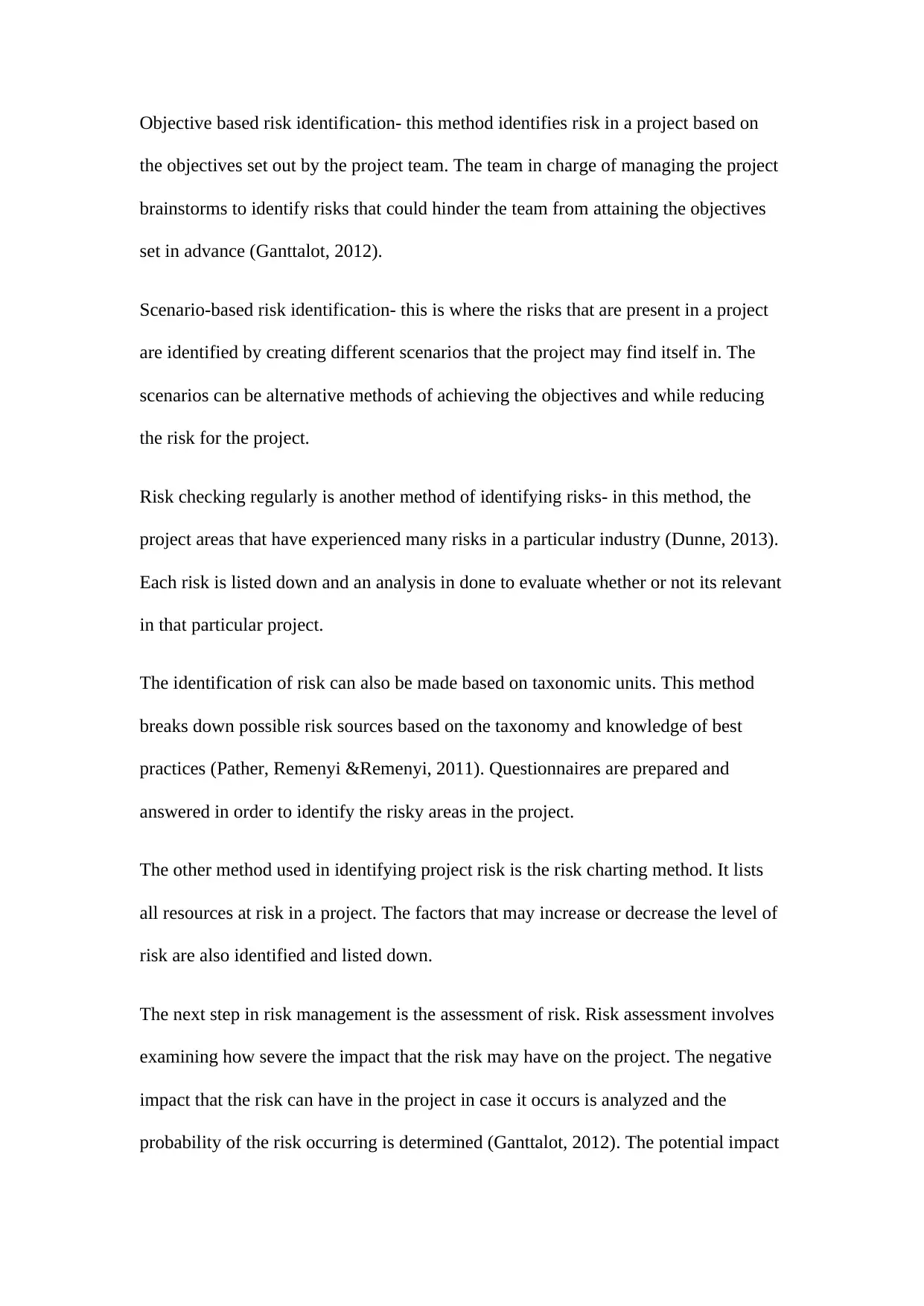
Objective based risk identification- this method identifies risk in a project based on
the objectives set out by the project team. The team in charge of managing the project
brainstorms to identify risks that could hinder the team from attaining the objectives
set in advance (Ganttalot, 2012).
Scenario-based risk identification- this is where the risks that are present in a project
are identified by creating different scenarios that the project may find itself in. The
scenarios can be alternative methods of achieving the objectives and while reducing
the risk for the project.
Risk checking regularly is another method of identifying risks- in this method, the
project areas that have experienced many risks in a particular industry (Dunne, 2013).
Each risk is listed down and an analysis in done to evaluate whether or not its relevant
in that particular project.
The identification of risk can also be made based on taxonomic units. This method
breaks down possible risk sources based on the taxonomy and knowledge of best
practices (Pather, Remenyi &Remenyi, 2011). Questionnaires are prepared and
answered in order to identify the risky areas in the project.
The other method used in identifying project risk is the risk charting method. It lists
all resources at risk in a project. The factors that may increase or decrease the level of
risk are also identified and listed down.
The next step in risk management is the assessment of risk. Risk assessment involves
examining how severe the impact that the risk may have on the project. The negative
impact that the risk can have in the project in case it occurs is analyzed and the
probability of the risk occurring is determined (Ganttalot, 2012). The potential impact
the objectives set out by the project team. The team in charge of managing the project
brainstorms to identify risks that could hinder the team from attaining the objectives
set in advance (Ganttalot, 2012).
Scenario-based risk identification- this is where the risks that are present in a project
are identified by creating different scenarios that the project may find itself in. The
scenarios can be alternative methods of achieving the objectives and while reducing
the risk for the project.
Risk checking regularly is another method of identifying risks- in this method, the
project areas that have experienced many risks in a particular industry (Dunne, 2013).
Each risk is listed down and an analysis in done to evaluate whether or not its relevant
in that particular project.
The identification of risk can also be made based on taxonomic units. This method
breaks down possible risk sources based on the taxonomy and knowledge of best
practices (Pather, Remenyi &Remenyi, 2011). Questionnaires are prepared and
answered in order to identify the risky areas in the project.
The other method used in identifying project risk is the risk charting method. It lists
all resources at risk in a project. The factors that may increase or decrease the level of
risk are also identified and listed down.
The next step in risk management is the assessment of risk. Risk assessment involves
examining how severe the impact that the risk may have on the project. The negative
impact that the risk can have in the project in case it occurs is analyzed and the
probability of the risk occurring is determined (Ganttalot, 2012). The potential impact
⊘ This is a preview!⊘
Do you want full access?
Subscribe today to unlock all pages.

Trusted by 1+ million students worldwide
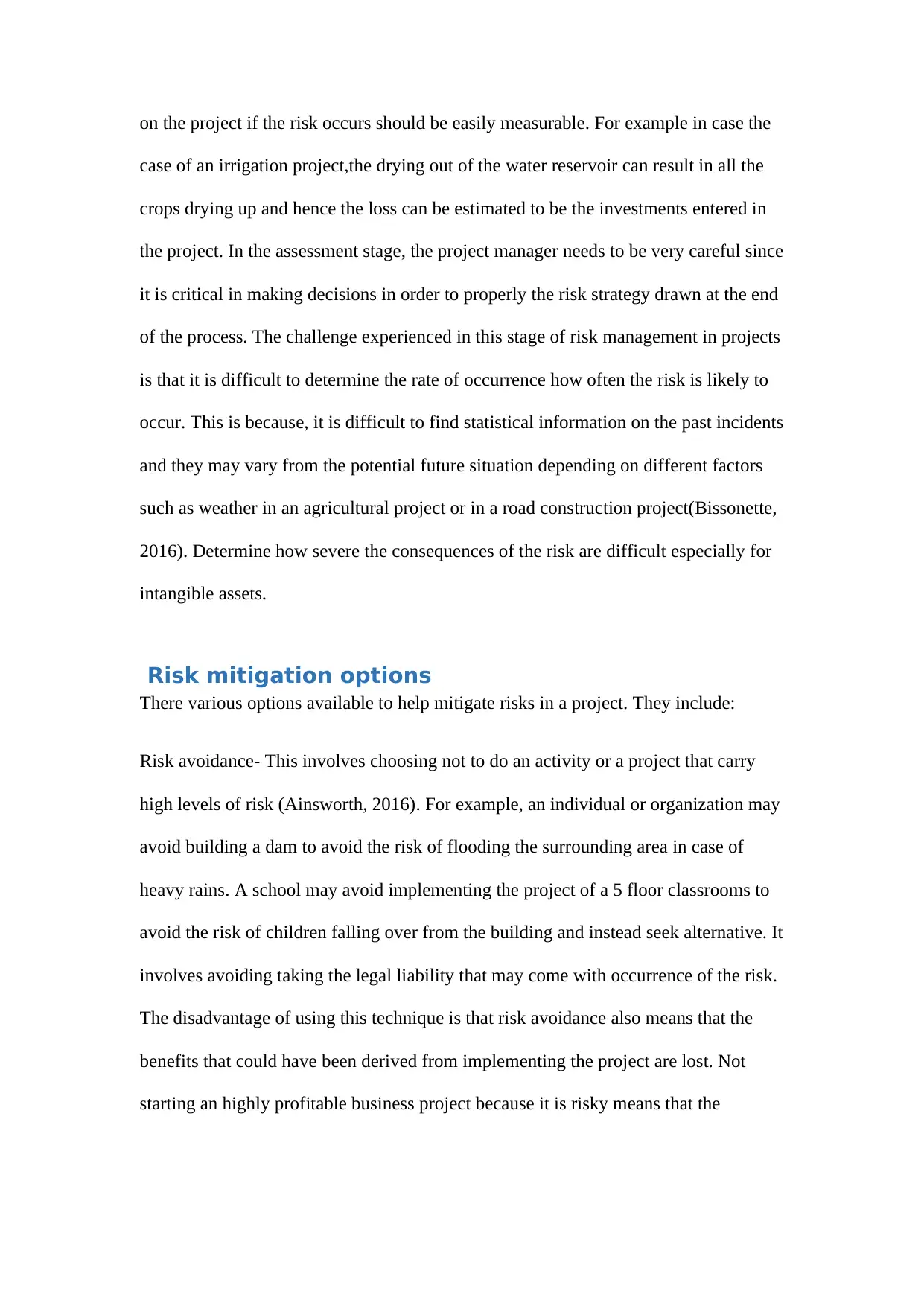
on the project if the risk occurs should be easily measurable. For example in case the
case of an irrigation project,the drying out of the water reservoir can result in all the
crops drying up and hence the loss can be estimated to be the investments entered in
the project. In the assessment stage, the project manager needs to be very careful since
it is critical in making decisions in order to properly the risk strategy drawn at the end
of the process. The challenge experienced in this stage of risk management in projects
is that it is difficult to determine the rate of occurrence how often the risk is likely to
occur. This is because, it is difficult to find statistical information on the past incidents
and they may vary from the potential future situation depending on different factors
such as weather in an agricultural project or in a road construction project(Bissonette,
2016). Determine how severe the consequences of the risk are difficult especially for
intangible assets.
Risk mitigation options
There various options available to help mitigate risks in a project. They include:
Risk avoidance- This involves choosing not to do an activity or a project that carry
high levels of risk (Ainsworth, 2016). For example, an individual or organization may
avoid building a dam to avoid the risk of flooding the surrounding area in case of
heavy rains. A school may avoid implementing the project of a 5 floor classrooms to
avoid the risk of children falling over from the building and instead seek alternative. It
involves avoiding taking the legal liability that may come with occurrence of the risk.
The disadvantage of using this technique is that risk avoidance also means that the
benefits that could have been derived from implementing the project are lost. Not
starting an highly profitable business project because it is risky means that the
case of an irrigation project,the drying out of the water reservoir can result in all the
crops drying up and hence the loss can be estimated to be the investments entered in
the project. In the assessment stage, the project manager needs to be very careful since
it is critical in making decisions in order to properly the risk strategy drawn at the end
of the process. The challenge experienced in this stage of risk management in projects
is that it is difficult to determine the rate of occurrence how often the risk is likely to
occur. This is because, it is difficult to find statistical information on the past incidents
and they may vary from the potential future situation depending on different factors
such as weather in an agricultural project or in a road construction project(Bissonette,
2016). Determine how severe the consequences of the risk are difficult especially for
intangible assets.
Risk mitigation options
There various options available to help mitigate risks in a project. They include:
Risk avoidance- This involves choosing not to do an activity or a project that carry
high levels of risk (Ainsworth, 2016). For example, an individual or organization may
avoid building a dam to avoid the risk of flooding the surrounding area in case of
heavy rains. A school may avoid implementing the project of a 5 floor classrooms to
avoid the risk of children falling over from the building and instead seek alternative. It
involves avoiding taking the legal liability that may come with occurrence of the risk.
The disadvantage of using this technique is that risk avoidance also means that the
benefits that could have been derived from implementing the project are lost. Not
starting an highly profitable business project because it is risky means that the
Paraphrase This Document
Need a fresh take? Get an instant paraphrase of this document with our AI Paraphraser
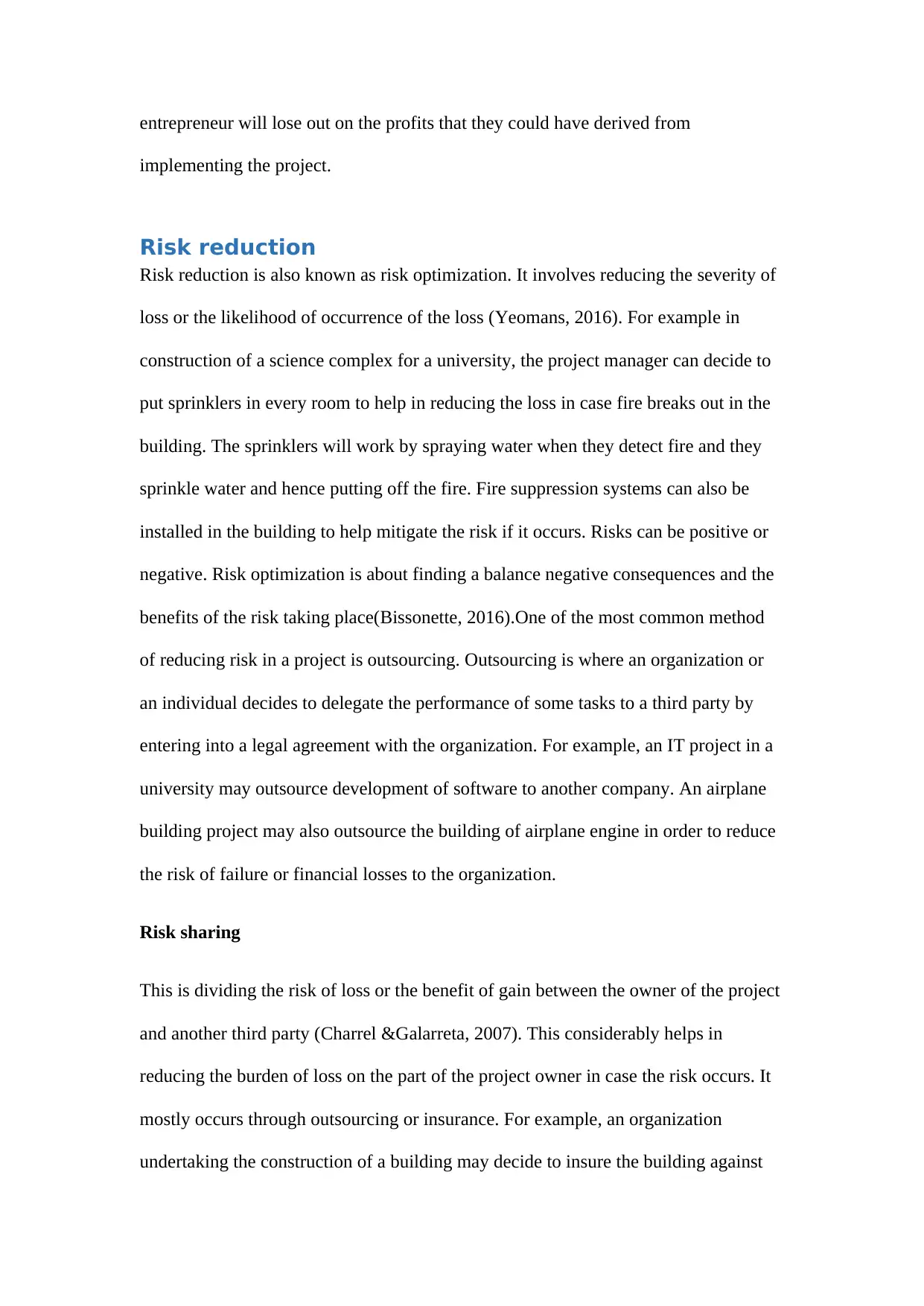
entrepreneur will lose out on the profits that they could have derived from
implementing the project.
Risk reduction
Risk reduction is also known as risk optimization. It involves reducing the severity of
loss or the likelihood of occurrence of the loss (Yeomans, 2016). For example in
construction of a science complex for a university, the project manager can decide to
put sprinklers in every room to help in reducing the loss in case fire breaks out in the
building. The sprinklers will work by spraying water when they detect fire and they
sprinkle water and hence putting off the fire. Fire suppression systems can also be
installed in the building to help mitigate the risk if it occurs. Risks can be positive or
negative. Risk optimization is about finding a balance negative consequences and the
benefits of the risk taking place(Bissonette, 2016).One of the most common method
of reducing risk in a project is outsourcing. Outsourcing is where an organization or
an individual decides to delegate the performance of some tasks to a third party by
entering into a legal agreement with the organization. For example, an IT project in a
university may outsource development of software to another company. An airplane
building project may also outsource the building of airplane engine in order to reduce
the risk of failure or financial losses to the organization.
Risk sharing
This is dividing the risk of loss or the benefit of gain between the owner of the project
and another third party (Charrel &Galarreta, 2007). This considerably helps in
reducing the burden of loss on the part of the project owner in case the risk occurs. It
mostly occurs through outsourcing or insurance. For example, an organization
undertaking the construction of a building may decide to insure the building against
implementing the project.
Risk reduction
Risk reduction is also known as risk optimization. It involves reducing the severity of
loss or the likelihood of occurrence of the loss (Yeomans, 2016). For example in
construction of a science complex for a university, the project manager can decide to
put sprinklers in every room to help in reducing the loss in case fire breaks out in the
building. The sprinklers will work by spraying water when they detect fire and they
sprinkle water and hence putting off the fire. Fire suppression systems can also be
installed in the building to help mitigate the risk if it occurs. Risks can be positive or
negative. Risk optimization is about finding a balance negative consequences and the
benefits of the risk taking place(Bissonette, 2016).One of the most common method
of reducing risk in a project is outsourcing. Outsourcing is where an organization or
an individual decides to delegate the performance of some tasks to a third party by
entering into a legal agreement with the organization. For example, an IT project in a
university may outsource development of software to another company. An airplane
building project may also outsource the building of airplane engine in order to reduce
the risk of failure or financial losses to the organization.
Risk sharing
This is dividing the risk of loss or the benefit of gain between the owner of the project
and another third party (Charrel &Galarreta, 2007). This considerably helps in
reducing the burden of loss on the part of the project owner in case the risk occurs. It
mostly occurs through outsourcing or insurance. For example, an organization
undertaking the construction of a building may decide to insure the building against
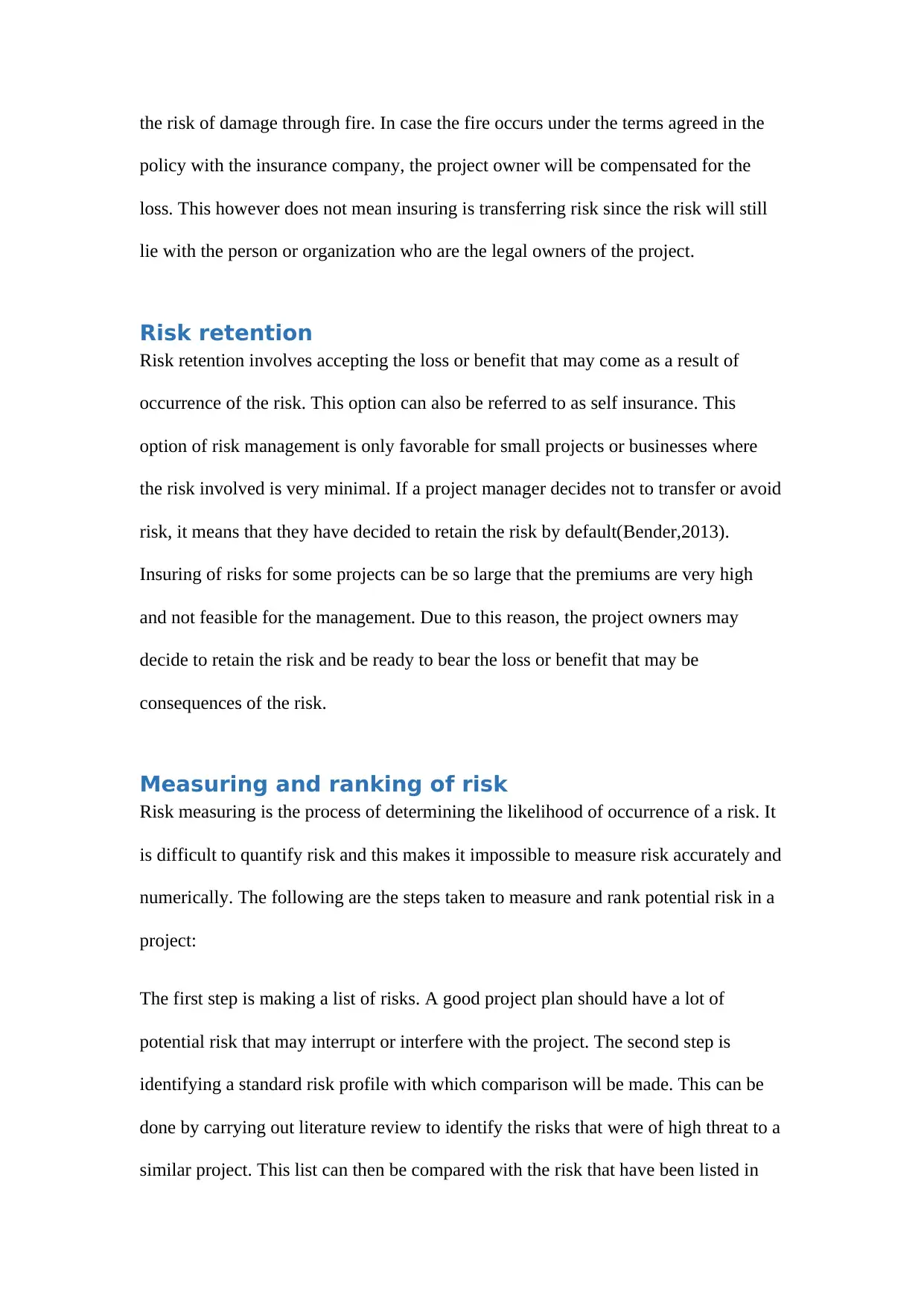
the risk of damage through fire. In case the fire occurs under the terms agreed in the
policy with the insurance company, the project owner will be compensated for the
loss. This however does not mean insuring is transferring risk since the risk will still
lie with the person or organization who are the legal owners of the project.
Risk retention
Risk retention involves accepting the loss or benefit that may come as a result of
occurrence of the risk. This option can also be referred to as self insurance. This
option of risk management is only favorable for small projects or businesses where
the risk involved is very minimal. If a project manager decides not to transfer or avoid
risk, it means that they have decided to retain the risk by default(Bender,2013).
Insuring of risks for some projects can be so large that the premiums are very high
and not feasible for the management. Due to this reason, the project owners may
decide to retain the risk and be ready to bear the loss or benefit that may be
consequences of the risk.
Measuring and ranking of risk
Risk measuring is the process of determining the likelihood of occurrence of a risk. It
is difficult to quantify risk and this makes it impossible to measure risk accurately and
numerically. The following are the steps taken to measure and rank potential risk in a
project:
The first step is making a list of risks. A good project plan should have a lot of
potential risk that may interrupt or interfere with the project. The second step is
identifying a standard risk profile with which comparison will be made. This can be
done by carrying out literature review to identify the risks that were of high threat to a
similar project. This list can then be compared with the risk that have been listed in
policy with the insurance company, the project owner will be compensated for the
loss. This however does not mean insuring is transferring risk since the risk will still
lie with the person or organization who are the legal owners of the project.
Risk retention
Risk retention involves accepting the loss or benefit that may come as a result of
occurrence of the risk. This option can also be referred to as self insurance. This
option of risk management is only favorable for small projects or businesses where
the risk involved is very minimal. If a project manager decides not to transfer or avoid
risk, it means that they have decided to retain the risk by default(Bender,2013).
Insuring of risks for some projects can be so large that the premiums are very high
and not feasible for the management. Due to this reason, the project owners may
decide to retain the risk and be ready to bear the loss or benefit that may be
consequences of the risk.
Measuring and ranking of risk
Risk measuring is the process of determining the likelihood of occurrence of a risk. It
is difficult to quantify risk and this makes it impossible to measure risk accurately and
numerically. The following are the steps taken to measure and rank potential risk in a
project:
The first step is making a list of risks. A good project plan should have a lot of
potential risk that may interrupt or interfere with the project. The second step is
identifying a standard risk profile with which comparison will be made. This can be
done by carrying out literature review to identify the risks that were of high threat to a
similar project. This list can then be compared with the risk that have been listed in
⊘ This is a preview!⊘
Do you want full access?
Subscribe today to unlock all pages.

Trusted by 1+ million students worldwide
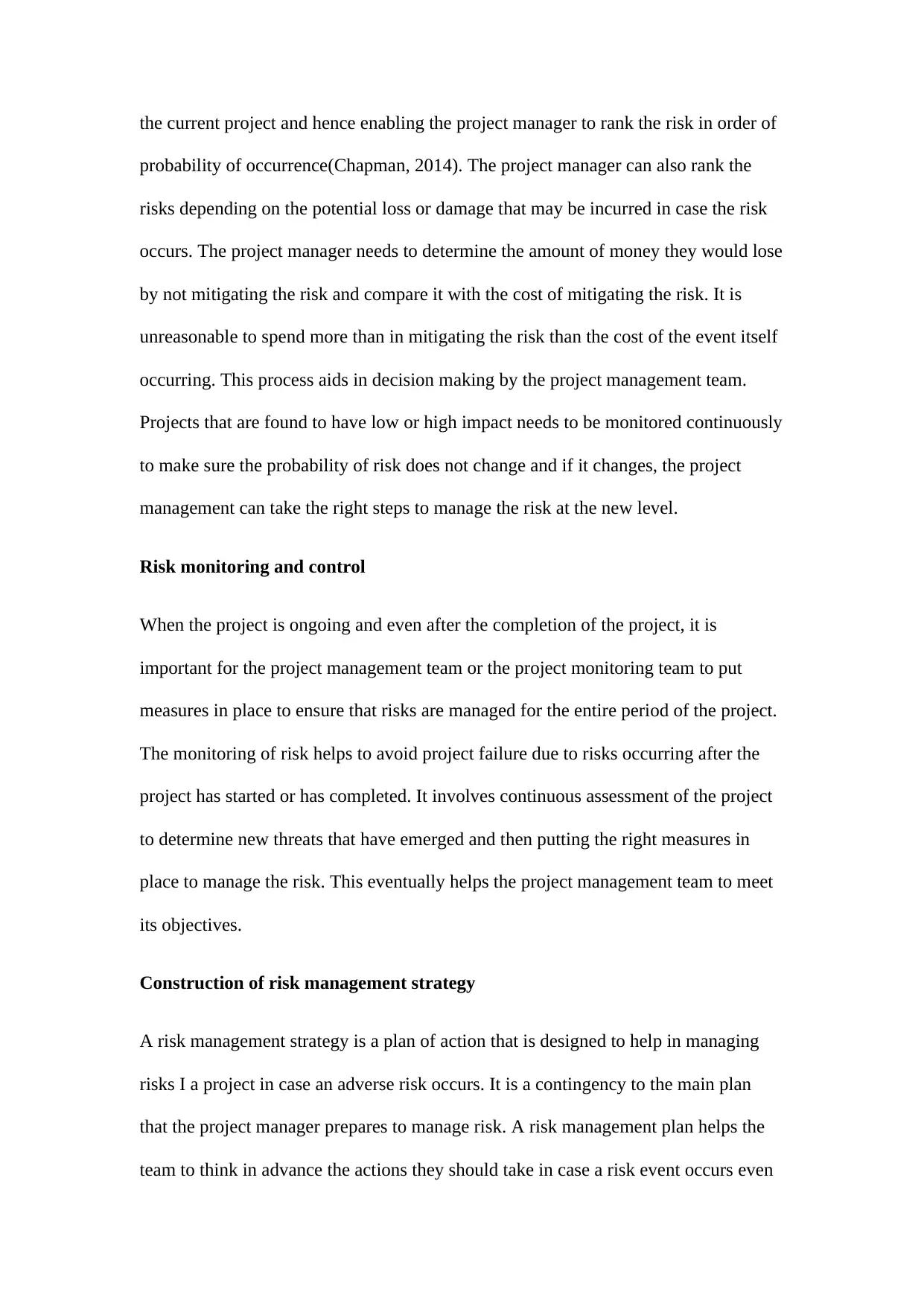
the current project and hence enabling the project manager to rank the risk in order of
probability of occurrence(Chapman, 2014). The project manager can also rank the
risks depending on the potential loss or damage that may be incurred in case the risk
occurs. The project manager needs to determine the amount of money they would lose
by not mitigating the risk and compare it with the cost of mitigating the risk. It is
unreasonable to spend more than in mitigating the risk than the cost of the event itself
occurring. This process aids in decision making by the project management team.
Projects that are found to have low or high impact needs to be monitored continuously
to make sure the probability of risk does not change and if it changes, the project
management can take the right steps to manage the risk at the new level.
Risk monitoring and control
When the project is ongoing and even after the completion of the project, it is
important for the project management team or the project monitoring team to put
measures in place to ensure that risks are managed for the entire period of the project.
The monitoring of risk helps to avoid project failure due to risks occurring after the
project has started or has completed. It involves continuous assessment of the project
to determine new threats that have emerged and then putting the right measures in
place to manage the risk. This eventually helps the project management team to meet
its objectives.
Construction of risk management strategy
A risk management strategy is a plan of action that is designed to help in managing
risks I a project in case an adverse risk occurs. It is a contingency to the main plan
that the project manager prepares to manage risk. A risk management plan helps the
team to think in advance the actions they should take in case a risk event occurs even
probability of occurrence(Chapman, 2014). The project manager can also rank the
risks depending on the potential loss or damage that may be incurred in case the risk
occurs. The project manager needs to determine the amount of money they would lose
by not mitigating the risk and compare it with the cost of mitigating the risk. It is
unreasonable to spend more than in mitigating the risk than the cost of the event itself
occurring. This process aids in decision making by the project management team.
Projects that are found to have low or high impact needs to be monitored continuously
to make sure the probability of risk does not change and if it changes, the project
management can take the right steps to manage the risk at the new level.
Risk monitoring and control
When the project is ongoing and even after the completion of the project, it is
important for the project management team or the project monitoring team to put
measures in place to ensure that risks are managed for the entire period of the project.
The monitoring of risk helps to avoid project failure due to risks occurring after the
project has started or has completed. It involves continuous assessment of the project
to determine new threats that have emerged and then putting the right measures in
place to manage the risk. This eventually helps the project management team to meet
its objectives.
Construction of risk management strategy
A risk management strategy is a plan of action that is designed to help in managing
risks I a project in case an adverse risk occurs. It is a contingency to the main plan
that the project manager prepares to manage risk. A risk management plan helps the
team to think in advance the actions they should take in case a risk event occurs even
Paraphrase This Document
Need a fresh take? Get an instant paraphrase of this document with our AI Paraphraser
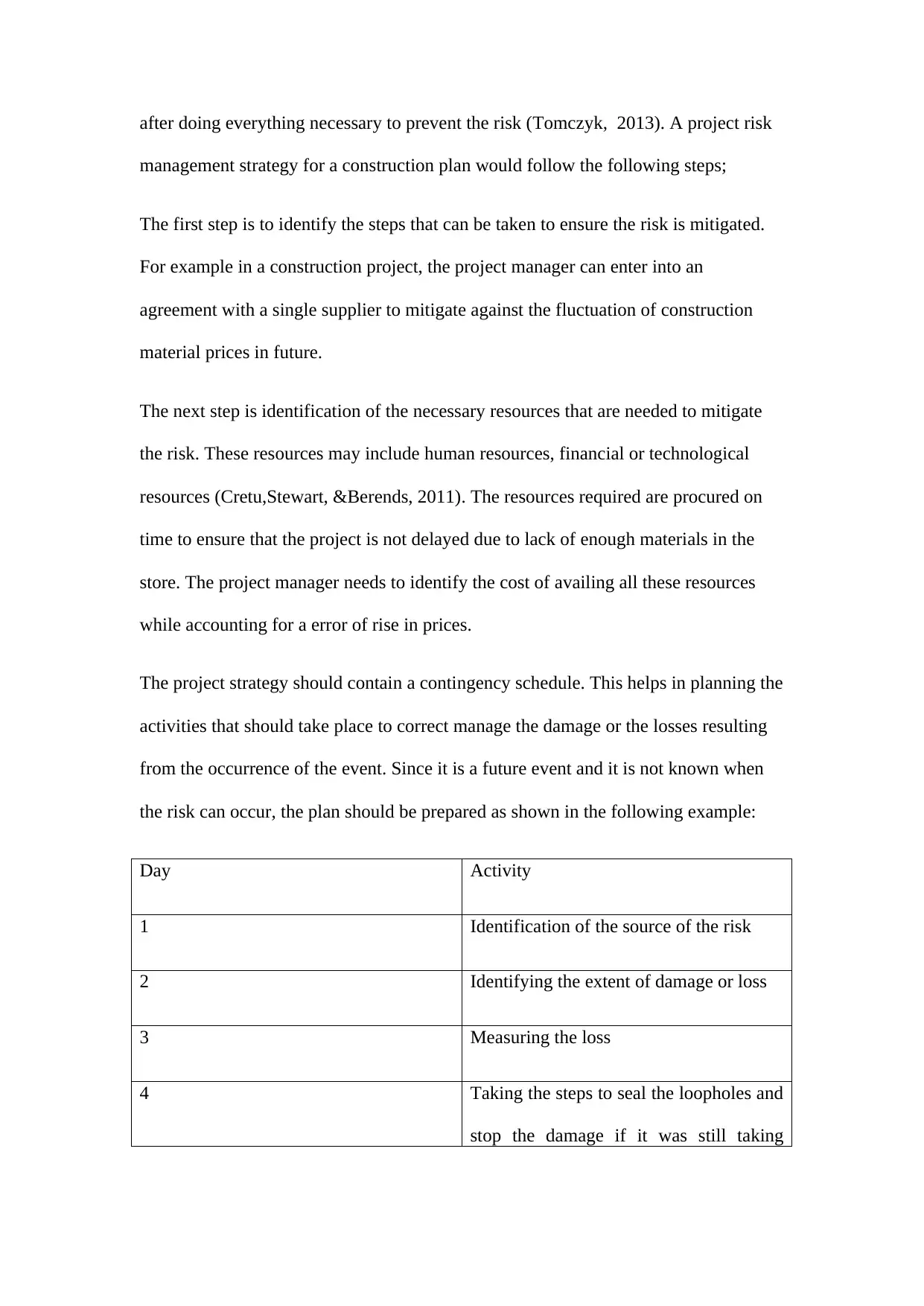
after doing everything necessary to prevent the risk (Tomczyk, 2013). A project risk
management strategy for a construction plan would follow the following steps;
The first step is to identify the steps that can be taken to ensure the risk is mitigated.
For example in a construction project, the project manager can enter into an
agreement with a single supplier to mitigate against the fluctuation of construction
material prices in future.
The next step is identification of the necessary resources that are needed to mitigate
the risk. These resources may include human resources, financial or technological
resources (Cretu,Stewart, &Berends, 2011). The resources required are procured on
time to ensure that the project is not delayed due to lack of enough materials in the
store. The project manager needs to identify the cost of availing all these resources
while accounting for a error of rise in prices.
The project strategy should contain a contingency schedule. This helps in planning the
activities that should take place to correct manage the damage or the losses resulting
from the occurrence of the event. Since it is a future event and it is not known when
the risk can occur, the plan should be prepared as shown in the following example:
Day Activity
1 Identification of the source of the risk
2 Identifying the extent of damage or loss
3 Measuring the loss
4 Taking the steps to seal the loopholes and
stop the damage if it was still taking
management strategy for a construction plan would follow the following steps;
The first step is to identify the steps that can be taken to ensure the risk is mitigated.
For example in a construction project, the project manager can enter into an
agreement with a single supplier to mitigate against the fluctuation of construction
material prices in future.
The next step is identification of the necessary resources that are needed to mitigate
the risk. These resources may include human resources, financial or technological
resources (Cretu,Stewart, &Berends, 2011). The resources required are procured on
time to ensure that the project is not delayed due to lack of enough materials in the
store. The project manager needs to identify the cost of availing all these resources
while accounting for a error of rise in prices.
The project strategy should contain a contingency schedule. This helps in planning the
activities that should take place to correct manage the damage or the losses resulting
from the occurrence of the event. Since it is a future event and it is not known when
the risk can occur, the plan should be prepared as shown in the following example:
Day Activity
1 Identification of the source of the risk
2 Identifying the extent of damage or loss
3 Measuring the loss
4 Taking the steps to seal the loopholes and
stop the damage if it was still taking
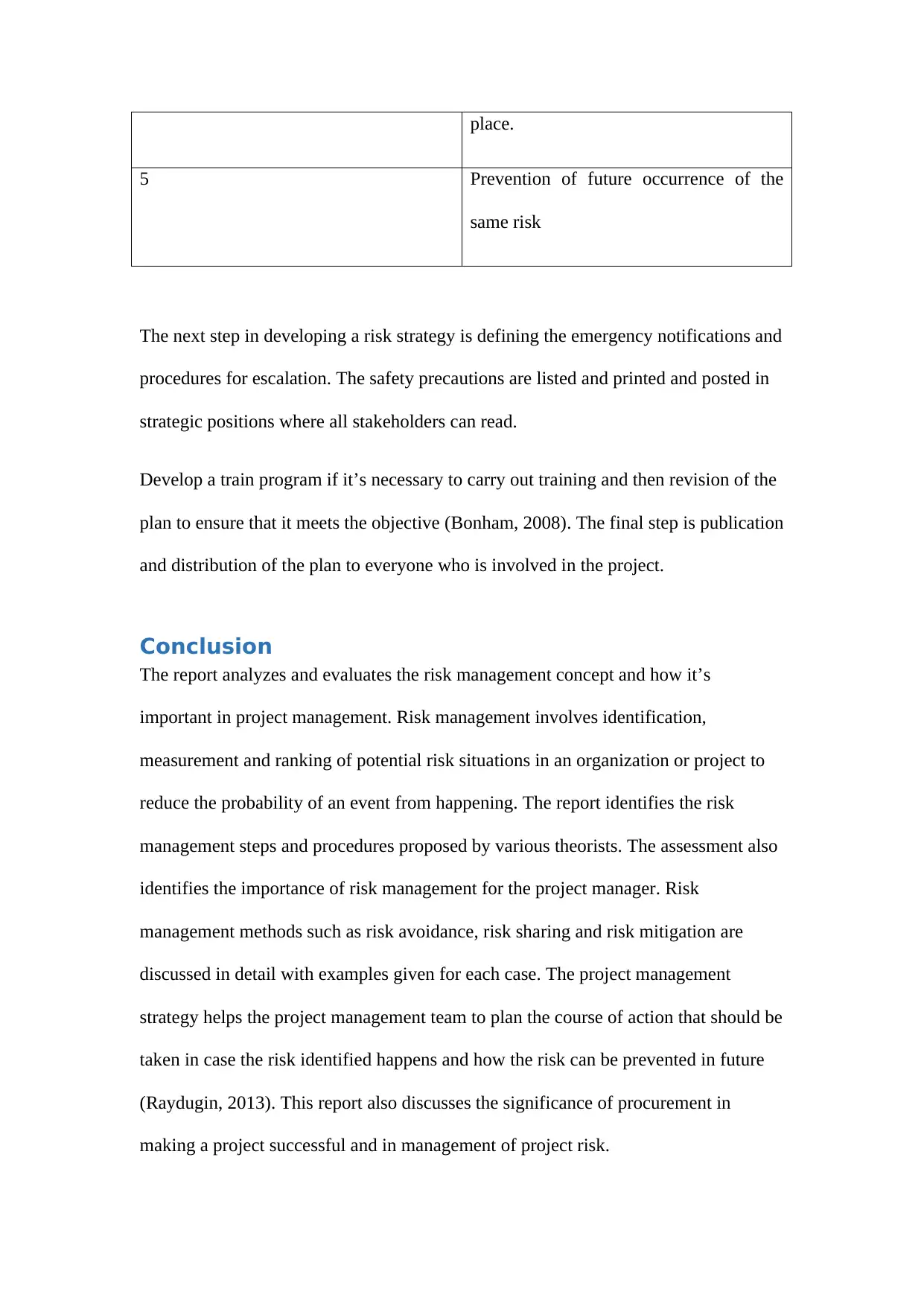
place.
5 Prevention of future occurrence of the
same risk
The next step in developing a risk strategy is defining the emergency notifications and
procedures for escalation. The safety precautions are listed and printed and posted in
strategic positions where all stakeholders can read.
Develop a train program if it’s necessary to carry out training and then revision of the
plan to ensure that it meets the objective (Bonham, 2008). The final step is publication
and distribution of the plan to everyone who is involved in the project.
Conclusion
The report analyzes and evaluates the risk management concept and how it’s
important in project management. Risk management involves identification,
measurement and ranking of potential risk situations in an organization or project to
reduce the probability of an event from happening. The report identifies the risk
management steps and procedures proposed by various theorists. The assessment also
identifies the importance of risk management for the project manager. Risk
management methods such as risk avoidance, risk sharing and risk mitigation are
discussed in detail with examples given for each case. The project management
strategy helps the project management team to plan the course of action that should be
taken in case the risk identified happens and how the risk can be prevented in future
(Raydugin, 2013). This report also discusses the significance of procurement in
making a project successful and in management of project risk.
5 Prevention of future occurrence of the
same risk
The next step in developing a risk strategy is defining the emergency notifications and
procedures for escalation. The safety precautions are listed and printed and posted in
strategic positions where all stakeholders can read.
Develop a train program if it’s necessary to carry out training and then revision of the
plan to ensure that it meets the objective (Bonham, 2008). The final step is publication
and distribution of the plan to everyone who is involved in the project.
Conclusion
The report analyzes and evaluates the risk management concept and how it’s
important in project management. Risk management involves identification,
measurement and ranking of potential risk situations in an organization or project to
reduce the probability of an event from happening. The report identifies the risk
management steps and procedures proposed by various theorists. The assessment also
identifies the importance of risk management for the project manager. Risk
management methods such as risk avoidance, risk sharing and risk mitigation are
discussed in detail with examples given for each case. The project management
strategy helps the project management team to plan the course of action that should be
taken in case the risk identified happens and how the risk can be prevented in future
(Raydugin, 2013). This report also discusses the significance of procurement in
making a project successful and in management of project risk.
⊘ This is a preview!⊘
Do you want full access?
Subscribe today to unlock all pages.

Trusted by 1+ million students worldwide
1 out of 14
Related Documents
Your All-in-One AI-Powered Toolkit for Academic Success.
+13062052269
info@desklib.com
Available 24*7 on WhatsApp / Email
![[object Object]](/_next/static/media/star-bottom.7253800d.svg)
Unlock your academic potential
Copyright © 2020–2025 A2Z Services. All Rights Reserved. Developed and managed by ZUCOL.





